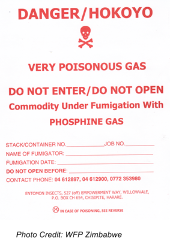- What We Do
- Agriculture and Food Security
- Democracy, Human Rights and Governance
- Economic Growth and Trade
- Education
- Environment and Global Climate Change
- Gender Equality and Women's Empowerment
- Global Health
- Humanitarian Assistance
- Transformation at USAID
- Water and Sanitation
- Working in Crises and Conflict
- U.S. Global Development Lab
Speeches Shim
USAID Development Food Assistance
For current environmental compliance policies and procedures, refer to the Request for Applications (RFA) for USAID Development Food Assistance. These policies tailor the USAID environmental compliance procedures for environmental impact assessment (22 CFR 216) and risk management (ADS 201mal) to the complex dynamics of USAID food assistance operating in some of the poorest countries worldwide.

Commodity Fumigation
All USAID Food Assistance must protect valuable, life-saving agricultural commodity from insect infestation at warehouses in ports and distribution points globally. Commodity is treated with the highly-effective, but very toxic, pesticide phosphine gas. To ensure the safe and effective use of this gas, USAID conducted a Programmatic Environmental Assessment (PEA) for Commodity Protection by Phosphine Fumigation in USAID Food Aid Programs which identified gaps and corrective actions for fumigation in warehouses. In particular, emphasizing issues of pesticide resistance reduction and integrated pest management approaches.
Annual Environmental Status Reporting
To verify that environmental safeguards are operating as planned, an Environmental Status Report (ESR) is submitted by awardees on an annual basis. This report describes the USAID program’s current status of implementing required environmental safeguard mitigations for a multi-year project. All awardees submit an ESR to USAID prior to the annual Pipeline Resource Estimate Proposal (PREP), together with the M&E Plan. The ESR establishes budget and staffing workplans for implementing environmental safeguard actions in the upcoming year of implementation. For additional information on developing and reviewing FFP budgets for environmental impact assessment elements, please refer to the USAID Environmental Compliance Budgeting Toolkit [PDF, 1.2MB].

Comment
Make a general inquiry or suggest an improvement.